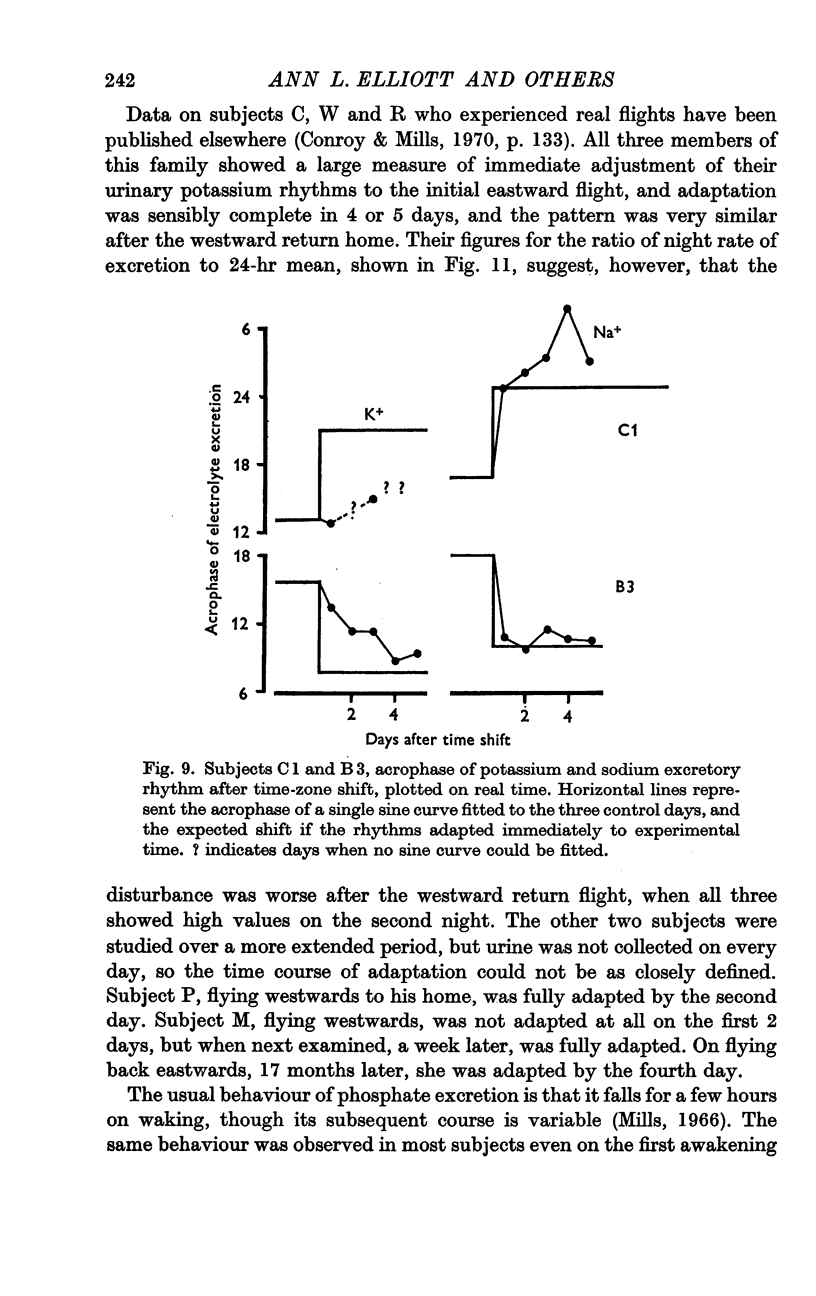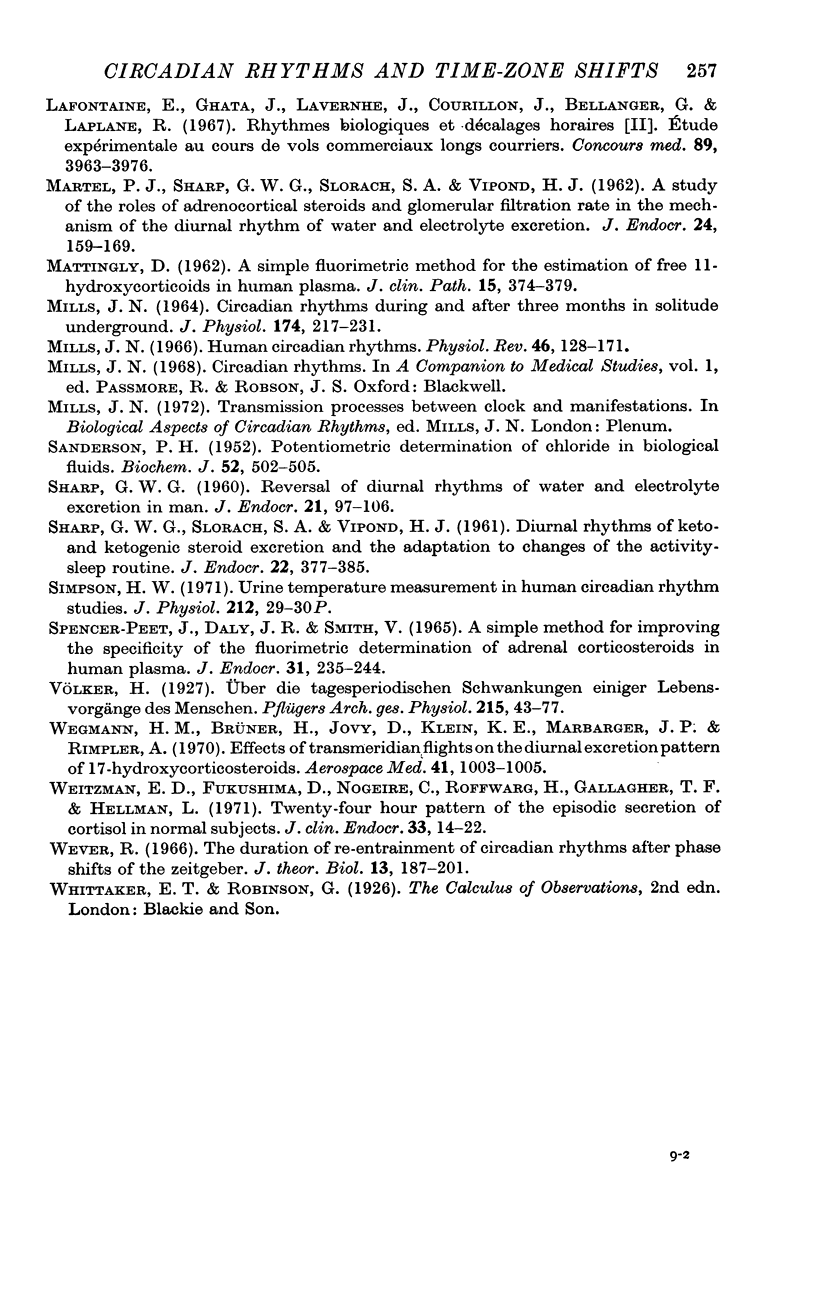Abstract
1. Observations were made upon five subjects who flew through 4½-6 time zones, four of them returning later to their starting point, and upon twenty-three subjects experiencing simulated 6 or 8 hr time zones shifts in either direction in an isolation unit.
2. Measurements were made of plasma concentration of 11-hydroxycorticosteroids, of body temperature, and of urinary excretion of sodium, potassium and chloride. Their rhythm was defined, where possible, by fitting a sine curve of period 24 hr to each separate 24-hr stretch of data and computing the acrophase, or maximum predicted by the sine curve.
3. The adaptation of the plasma steroid rhythm was assessed by the presence of a sharp fall in concentration after the sample collected around 08.00 hr. The time course of adaptation varied widely between individuals; it was usually largely complete by the fourth day after westward, and rather later after eastward, flights. After time shift the pattern often corresponded neither to an adapted nor to an unadapted one, and in a subject followed for many months after a real flight a normal amplitude only appeared 2-3 months after flight.
4. Temperature rhythm adapted by a movement of the acrophase, without change in amplitude, although on some days no rhythm could be observed. This movement was always substantial even on the first day, and was usually nearly complete by the fifth.
5. High nocturnal excretion of electrolyte was often seen in the early days after time shift, more notably after simulated westward flights. Adaptation of urinary electrolyte rhythms usually proceeded as with temperature, but the movement of the acrophase was slower, more variable between individuals, more erratic, and sometimes reversed after partial adaptation. On a few days there were two maxima corresponding to those expected on real and on experimental time.
6. Sodium excretion was much less regular than that of potassium, but adapted more rapidly to time shift, so that the two often became completely dissociated. Chloride behaved much as sodium.
7. The time course of adaptation of the plasma steroid and urinary potassium rhythms were sufficiently similar to suggest a causal connexion. The time course of adaptation of the temperature rhythm did not coincide with that of any other component considered here.
Full text
PDF






























Selected References
These references are in PubMed. This may not be the complete list of references from this article.
- Aschoff J. Desynchronization and resynchronization of human circadian rhythms. Aerosp Med. 1969 Aug;40(8):844–849. [PubMed] [Google Scholar]
- Colquhoun W. P., Blake M. J., Edwards R. S. Experimental studies of shift-work I: A comparison of 'rotating' and 'stabilized' 4-hour shift systems. Ergonomics. 1968 Sep;11(5):437–453. doi: 10.1080/00140136808930993. [DOI] [PubMed] [Google Scholar]
- Colquhoun W. P., Blake M. J., Edwards R. S. Experimental studies of shift-work. 3. Stabilized 12-hour shift system. Ergonomics. 1969 Nov;12(6):865–882. doi: 10.1080/00140136908931104. [DOI] [PubMed] [Google Scholar]
- Colquhoun W. P., Blake M. J., Edwards R. S. Experimental studies of shift-work. II. Stabilized 8-hour shift systems. Ergonomics. 1968 Nov;11(6):527–546. doi: 10.1080/00140136808931006. [DOI] [PubMed] [Google Scholar]
- Conroy R. T., Elliott A. L., Fort A., Mills J. N. Circadian rhythms before and after a flight from India. J Physiol. 1969 Oct;204(2):85P–85P. [PubMed] [Google Scholar]
- Conroy R. T., Hall M. D. Adrenal cortical function and body temperature rhythms after a transatlantic flight. J Physiol. 1969 Feb;200(2):123P–123P. [PubMed] [Google Scholar]
- Elliott A. L., Mills J. N. Urinary potassium rhythms before and after transatlantic flight. J Physiol. 1969 Feb;200(2):122P–122P. [PubMed] [Google Scholar]
- FLINK E. B., DOE R. P. Effect of sudden time displacement by air travel on synchronization of adrenal function. Proc Soc Exp Biol Med. 1959 Mar;100(3):498–501. doi: 10.3181/00379727-100-24674. [DOI] [PubMed] [Google Scholar]
- Fort A., Mills J. N. Fitting sine curves to 24 h urinary data. Nature. 1970 May 16;226(5246):657–658. doi: 10.1038/226657a0. [DOI] [PubMed] [Google Scholar]
- Fort A. The effects of rapid change in time zone on circadian variation in physiological functions. J Physiol. 1969 Feb;200(2):124P–124P. [PubMed] [Google Scholar]
- GERRITZEN F. The diurnal rhythm in water, chloride, sodium and potassium excretion during a rapid displacement from East to West and vice versa. Aerosp Med. 1962 Jun;33:697–701. [PubMed] [Google Scholar]
- Gerritzen F. Influence of light on human circadian rhythms. Aerosp Med. 1966 Jan;37(1):66–70. [PubMed] [Google Scholar]
- Gerritzen F., Strengers T., Esser S. Studies on the influence of fast transportation on the circadian excretion pattern of the kidney in humans. Aerosp Med. 1969 Mar;40(3):264–271. [PubMed] [Google Scholar]
- Hauty G. T., Adams T. Phase shifts of the human circadian system and performance deficit during the periods of transition. 3. North-South flight. Aerosp Med. 1966 Dec;37(12):1257–1262. [PubMed] [Google Scholar]
- Hauty G. T., Adams T. Phase shifts of the human circadian system and performance deficit during the periods of transition. II. West-East flight. Aerosp Med. 1966 Oct;37(10):1027–1033. [PubMed] [Google Scholar]
- Hauty G. T., Adams T. Phase shifts of the human circadian system and performance deficit during the periods of transition: I. East-west flight. Aerosp Med. 1966 Jul;37(7):668–674. [PubMed] [Google Scholar]
- Krieger D. T., Allen W., Rizzo F., Krieger H. P. Characterization of the normal temporal pattern of plasma corticosteroid levels. J Clin Endocrinol Metab. 1971 Feb;32(2):266–284. doi: 10.1210/jcem-32-2-266. [DOI] [PubMed] [Google Scholar]
- MARTEL P. J., SHARP G. W., SLORACH S. A., VIPOND H. J. A study of the roles of adrenocortical steroids and glomerular filtration rate in the mechanism of the diurnal rhythm of water and electrolyte excretion. J Endocrinol. 1962 Apr;24:159–169. doi: 10.1677/joe.0.0240159. [DOI] [PubMed] [Google Scholar]
- MATTINGLY D. A simple fluorimetric method for the estimation of free 11-hydroxycorticoids in human plasma. J Clin Pathol. 1962 Jul;15:374–379. doi: 10.1136/jcp.15.4.374. [DOI] [PMC free article] [PubMed] [Google Scholar]
- MILLS J. N. CIRCADIAN RHYTHMS DURING AND AFTER THREE MONTHS IN SOLITUDE UNDERGROUND. J Physiol. 1964 Nov;174:217–231. doi: 10.1113/jphysiol.1964.sp007483. [DOI] [PMC free article] [PubMed] [Google Scholar]
- Mills J. N. Human circadian rhythms. Physiol Rev. 1966 Jan;46(1):128–171. doi: 10.1152/physrev.1966.46.1.128. [DOI] [PubMed] [Google Scholar]
- SANDERSON P. H. Potentiometric determination of chloride in biological fluids. Biochem J. 1952 Nov;52(3):502–505. doi: 10.1042/bj0520502. [DOI] [PMC free article] [PubMed] [Google Scholar]
- SPENCER PEET J., DALY J. R., SMITH V. A SIMPLE METHOD FOR IMPROVING THE SPECIFICITY OF THE FLUORIMETRIC DETERMINATION OF ADRENAL CORTICOSTEROIDS IN HUMAN PLASMA. J Endocrinol. 1965 Feb;31:235–244. doi: 10.1677/joe.0.0310235. [DOI] [PubMed] [Google Scholar]
- Simpson H. W. Urine temperature measurement in human circadian rhythm studies. J Physiol. 1971 Jan;212(2):29P–30P. [PubMed] [Google Scholar]
- Wegmann H. M., Brüner H., Jovy D., Klein K. E., Marbarger J. P., Rimpler A. Effects of transmeridian flights on the diurnal excretion pattern of 17-hydroxycorticosteroids. Aerosp Med. 1970 Sep;41(9):1003–1005. [PubMed] [Google Scholar]
- Weitzman E. D., Fukushima D., Nogeire C., Roffwarg H., Gallagher T. F., Hellman L. Twenty-four hour pattern of the episodic secretion of cortisol in normal subjects. J Clin Endocrinol Metab. 1971 Jul;33(1):14–22. doi: 10.1210/jcem-33-1-14. [DOI] [PubMed] [Google Scholar]


